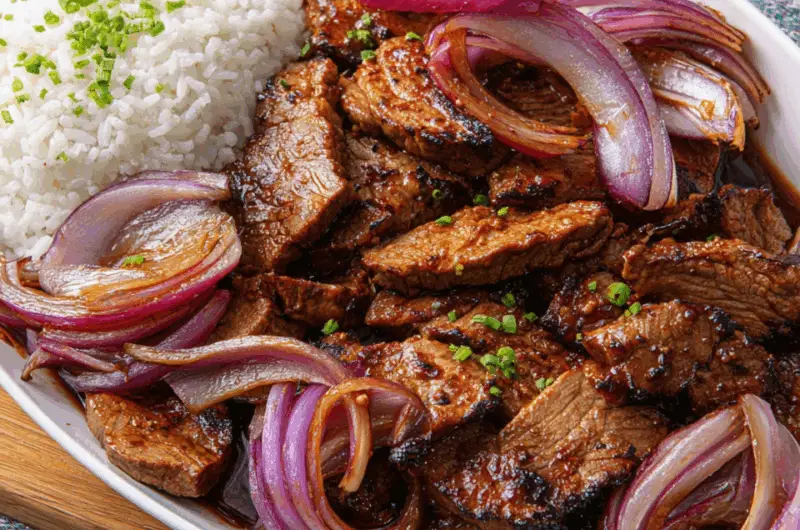Filipino Beef Steak, or Bistek Tagalog, is a flavorful and comforting dish that perfectly balances the savory, slightly tangy taste of soy sauce and Worcestershire sauce with the richness of tender beef slices. The addition of garlic and onions enhances the overall aroma, making this dish both irresistible and comforting.
This dish is perfect for a quick, satisfying dinner or to impress guests at a gathering. The simple marinade elevates the flavor of the beef, and the optional garnish of crispy garlic chips adds an extra crunch. Pair it with steamed rice for a complete and hearty Filipino meal.
Full Recipe:
-
1 1/2 pounds sirloin beef steak, thinly sliced
-
3 tablespoons soy sauce
-
1 tablespoon Worcestershire sauce
-
2 teaspoons fresh lemon juice
-
3 cloves garlic, minced
-
1 teaspoon salt
-
1/2 teaspoon ground black pepper
-
1/2 teaspoon sugar
-
1/2 cup water
-
1 tablespoon vegetable oil
-
1 onion, thinly sliced
-
1 tablespoon olive oil
-
1 teaspoon ground black pepper (for garnish)
-
1 tablespoon fried garlic chips (optional, for garnish)
Directions:
-
Combine soy sauce, Worcestershire sauce, lemon juice, minced garlic, salt, pepper, sugar, and water in a bowl. Stir well to create a marinade.
-
Place the beef slices in a shallow bowl, pour the marinade over them, and let marinate for at least 30 minutes (or overnight for more flavor).
-
Heat vegetable oil in a skillet or pan over medium-high heat.
-
Sauté the onions until softened and lightly browned, about 3-5 minutes.
-
Add the marinated beef to the pan, cooking for about 5-7 minutes, or until the beef is cooked through and tender.
-
Once the beef is cooked, pour any remaining marinade over the meat, letting it simmer for another minute to reduce and thicken slightly.
-
Garnish with fresh ground black pepper and fried garlic chips (if using). Serve hot.
Prep Time: 10 minutes / Cooking Time: 15 minutes / Total Time: 25 minutes
Kcal: 320 kcal / Servings: 4 servings
Filipino Beef Steak: A Traditional and Flavorful Dish
Filipino Beef Steak, or Bistek Tagalog, is a beloved Filipino dish that brings together the savory and slightly tangy flavors of soy sauce, Worcestershire sauce, and garlic, complemented by the natural tenderness of beef. This dish is not only a staple in Filipino homes but has also gained recognition in international kitchens due to its delicious taste and simple preparation. Whether served for family gatherings or special occasions, Filipino Beef Steak is guaranteed to leave a lasting impression with its rich flavors and aromatic appeal.
Origins and Cultural Significance of Filipino Beef Steak
Bistek Tagalog is a traditional Filipino dish with deep historical roots. It is often considered a symbol of Filipino hospitality, typically served during family meals or festive occasions. The name “Bistek” is derived from the English word “beef steak,” a nod to the dish’s main ingredient. However, the Filipino version has distinct regional variations that infuse it with a unique cultural identity.
The dish reflects the fusion of indigenous Filipino flavors with influences from the country’s colonial past. The use of soy sauce in Filipino cuisine, for example, can be traced back to the influence of Chinese immigrants who introduced soy products to the islands. Similarly, Worcestershire sauce, often used in Filipino Beef Steak, was likely brought to the Philippines by Western traders. Despite these external influences, Filipino Beef Steak retains its unmistakable Filipino essence, thanks to local ingredients like calamansi (Filipino lime), which gives the dish a refreshing citrusy zing.
The Flavor Profile: Savory, Tangy, and Rich
The allure of Filipino Beef Steak lies in its complex and balanced flavor profile. At its core, the dish is savory, with soy sauce and Worcestershire sauce playing a starring role in the marinade. The soy sauce provides a salty, umami flavor, while the Worcestershire sauce adds a hint of tanginess and depth. The addition of fresh garlic creates an aromatic foundation that penetrates the beef, making every bite a flavorful experience.
Lemon juice or calamansi, a small Filipino lime, is sometimes added to the marinade to give the dish a slight tang. This citrusy note cuts through the richness of the beef and adds a refreshing balance to the flavors. The onions, which are sautéed until soft and caramelized, provide a natural sweetness that contrasts beautifully with the salty and tangy marinade.
Why Filipino Beef Steak is a Perfect Meal for Every Occasion
Filipino Beef Steak is versatile and can be enjoyed at any time of the day. It’s a dish that seamlessly fits into both casual and formal settings. Whether you’re preparing a weeknight dinner or hosting a special gathering, this dish is sure to impress your guests and family members alike.
The preparation process is straightforward, which makes it an excellent choice for busy individuals or those looking for a quick yet delicious meal. With a marinade time of just 30 minutes, the beef absorbs all the flavors it needs, and the cooking process takes only around 15 minutes. As such, you can have this flavorful dish ready to serve in under an hour—ideal for those with limited time to cook but who still crave an authentic and flavorful meal.
Filipino Beef Steak also pairs wonderfully with a variety of side dishes. Traditionally, it is served with a heaping plate of steamed rice, which helps to absorb the savory marinade and complete the meal. Other sides like sautéed vegetables, mashed potatoes, or even a simple salad can complement the dish to add variety and balance to the meal.
Nutritional Benefits of Filipino Beef Steak
While Filipino Beef Steak is known for its bold flavors, it also provides a range of nutritional benefits. Beef is an excellent source of high-quality protein, essential for building and repairing tissues in the body. It also contains important vitamins and minerals like iron, zinc, and B vitamins, which play crucial roles in energy production, immune function, and red blood cell production.
However, as with any meat-based dish, moderation is key. Opt for lean cuts of beef to reduce the intake of unhealthy fats. If you’re looking for a healthier variation, you can substitute the beef with chicken breast or tofu for a lighter alternative that still delivers rich flavors. The onions and garlic in this dish add a wealth of antioxidants, which are beneficial for immune health.
The combination of savory, tangy flavors and nutritious beef makes Filipino Beef Steak a wholesome dish that can be enjoyed by people of all ages.
How to Customize Filipino Beef Steak to Your Taste
One of the reasons Filipino Beef Steak remains so popular is its versatility. While the traditional recipe calls for beef sirloin, you can easily substitute this with other cuts of beef such as rib-eye or flank steak, depending on your preference. Some variations also call for additional seasonings or garnishes to enhance the flavor, such as bay leaves, soy sauce with garlic powder, or even a dash of hot sauce for an extra kick.
For those who prefer a slightly sweeter dish, you can add a small amount of honey or brown sugar to the marinade. This can help balance the acidity of the lemon or calamansi, resulting in a richer, more complex flavor profile. You can also experiment with the texture of the beef by choosing thicker or thinner cuts, depending on how tender you like your steak.
Serving Suggestions and Pairings
As previously mentioned, Filipino Beef Steak is typically served with steamed rice, which absorbs the savory sauce. But there are plenty of other side dish ideas to elevate the meal. Consider pairing it with a fresh cucumber salad or sautéed vegetables like bok choy, green beans, or carrots for a light and colorful contrast. For a more indulgent option, mashed potatoes or even roasted vegetables would work wonderfully with the tender beef.
For a more authentic Filipino experience, you can serve the dish with pancit (noodles), which is often served during celebratory meals in the Philippines. The combination of noodles and beef creates a satisfying and festive meal that will transport you to the heart of Filipino cuisine.
Tips for Perfecting Filipino Beef Steak
-
Marinate the Beef: Marinating the beef for at least 30 minutes allows the flavors to penetrate the meat. For an even richer taste, marinate the beef overnight in the refrigerator.
-
Choose the Right Cut of Beef: Select tender cuts of beef like sirloin, rib-eye, or flank steak. These cuts absorb the marinade well and cook quickly.
-
Cook on Medium Heat: While cooking the beef, avoid cooking it on high heat, as this may cause it to toughen. Instead, cook the beef on medium heat to ensure it stays tender and juicy.
-
Don’t Overcook the Beef: Filipino Beef Steak is best when the beef is tender and juicy. Overcooking it can lead to a dry texture, so be mindful of cooking times.
Conclusion: A Timeless Filipino Dish for Every Home
Filipino Beef Steak is a delicious and versatile dish that has stood the test of time in Filipino cuisine. Its rich, savory flavors, combined with tender beef and aromatic garlic, create a comforting and satisfying meal that can be enjoyed at any time. Whether you’re cooking for a casual dinner or hosting a special occasion, Filipino Beef Steak is sure to impress and delight.
By following the basic recipe, you can also experiment with different variations and pairings to make the dish your own. Whether you prefer a sweeter flavor, a spicier kick, or extra garlic, Filipino Beef Steak is a dish that can be adapted to suit your personal taste.
Not only does this dish offer incredible flavor and nutritional benefits, but it also provides a wonderful way to explore the culinary richness of Filipino culture. So, next time you’re in the mood for something comforting and flavorful, try your hand at Filipino Beef Steak—your taste buds will thank you!








